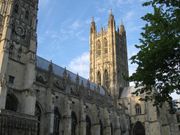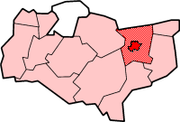Canterbury
2007 Schools Wikipedia Selection. Related subjects: Geography of Great Britain
| Canterbury | ||
|---|---|---|
|
|
||
| Statistics | ||
| Population: | 42,259 (2001) | |
| Ordnance Survey | ||
| OS grid reference: | TR145575 | |
| Administration | ||
| District: | City of Canterbury | |
| Shire county: | Kent | |
| Region: | South East England | |
| Constituent country: | England | |
| Sovereign state: | United Kingdom | |
| Other | ||
| Ceremonial county: | Kent | |
| Historic county: | Kent | |
| Services | ||
| Police force: | Kent Police | |
| Fire and rescue: | {{{Fire}}} | |
| Ambulance: | South East Coast | |
| Post office and telephone | ||
| Post town: | CANTERBURY | |
| Postal district: | CT | |
| Dialling code: | 01227 | |
| Politics | ||
| UK Parliament: | Canterbury | |
| European Parliament: | South East England | |
Canterbury is a cathedral city in east Kent in South East England and is the seat of the Archbishop of Canterbury, the Primate of All England, head of the Church of England and of the worldwide Anglican Communion.
History
Early history
There has been a settlement in Canterbury since prehistoric times. Bronze Age finds, and Neolithic round barrows have been discovered in the area; and before the Roman arrival Durovernon (British duro "fort", verno "swamp") was the most important settlement in Kent.
Canterbury (known in Latin as Durovernum Cantiacorum) became a Roman administrative centre: it lay at the junction of three roads from their ports of Regulbium ( Reculver), Dubris (Dover) and Lemanis ( Lympne); and it stood on what has become known as Watling Street. The city walls and one of the city gates remain.
The name Canterbury derives from the Old English Cantwarebyrig, meaning "fortress of the men of Kent". The bury element is a form of borough, which has cognates in words and place names in virtually every Indo-European and Semitic language, as well as others. For a fuller explanation, see under borough.
A Motte and Bailey castle was constructed in Canterbury by the Normans soon after the Norman Conquest, but this was soon replaced by the stone keep of Canterbury Castle which still stands today.
Religious significance
In 596 Pope Gregory the Great sent Augustine to convert England to Christianity. This was the first ever papal mission, and Augustine built a priory on the site of the present cathedral precincts in AD 597. He also built an abbey outside the city walls where he was buried: as were other early archbishops. Though St. Gregory had planned the division of England into two archbishoprics, one at London and one at York, Augustine's success at Canterbury explains how the southern archiepiscopal see came to be fixed there instead of at London. The first beginnings of the diocese are told by St. Bede (Hist. Eccl., I, xxxiii). "When Augustine, the first Archbishop of Canterbury, assumed the episcopal throne in that royal city, he recovered therein, by the King's assistance, a church which, as he was told, had been constructed by the original labour of Roman believers. This church he consecrated in the name of the Saviour, our God and Lord Jesus Christ, and there he established an habitation for himself and all his successors". The church was Saint Martin's, which is still in use today, and is considered the oldest church in England still in use. The Ancient Diocese of Canterbury was the Mother-Church and Primatial See of All England, from 597 till the death of the last Catholic Archbishop, Cardinal Pole, in 1558.
In the 16th Century the Church of England split from Rome under Henry VIII.
St Augustine's Abbey was destroyed during the Dissolution of the Monasteries ordered by Henry VIII, although ruins remain. During this time Canterbury became the centre of the new Church of England, although a Catholic shrine remains. At the same time, the ancient religious school was refounded as the King's School. Canterbury Cathedral is the burial place of King Henry IV and of Edward the Black Prince, but is most famous as the scene of the murder of Thomas Becket in 1170. As a result of this event, Canterbury became a major pilgrimage site, inspiring Geoffrey Chaucer to write The Canterbury Tales in 1387. The Hospital of St Thomas was a place of lodging for pilgrims in the city. The city is also associated with the family of Thomas More (his head is buried at the church of St. Dunstan's, Canterbury, and his body at St. Peter ad Vincula at the Tower of London ).
The city is also the start/finish point for many pilgrimage routes, such as the Via Francigena to Rome, the Pilgrims' Way to Winchester and the route from Southwark taken in The Canterbury Tales.
- A comprehensive article on the Abbey is here.
Later history
The city became a county corporate in 1461.
French Protestant refugees settled in the city during the sixteenth century: here they introduced silk-making.
As a historic county corporate, Canterbury was made a county borough under the Local Government Act 1888. It was the smallest such county borough, and never exceeded the 50,000 population limit initially required - the 1971 cenuss reported a population of 33,175. Under the Local Government Act 1972 it formed part of the larger Canterbury district of Kent.
During World War II the city was severely damaged by bombing after it was targeted by the Luftwaffe in the Baedeker Blitz. There is footage of the devastated areas in the 1944 film A Canterbury Tale, by film directors Michael Powell and Emeric Pressburger. The film is a celebration of the city, the Pilgrim's Way, and the Chaucerian stories, not a re-telling of the original tales.
Post-war large scale redevelopment of the city centre started quickly with the rebuilding of much of the bomb damaged east of the city, including what is now the Whitefriar's development. The ring-road was constructed some time after in stages to alleviate growing traffic problems in the city centre, which was then pedestrianised.
Canterbury today is a major city for tourism with Canterbury Cathedral alone attracting 1.2 million visitors in 2001. It still contains many ancient buildings and modern building development within the medieval town centre is strictly regulated.
During 2004-5 the Whitefriars area of the city underwent major redevelopment and the associated archeological research was called the " Big Dig". Canterbury now has a much larger shopping attraction due to the Whitefriars development, many of the shops have undergone major redevelopment, as has the city's bus station. Locally, however, the development has been criticised for causing empty buildings in other parts of the town, due to shop movement and the closure of several local shops under competition from the increased chain store presence. For example, the Boots the Chemist seen in the 1944 A Canterbury Tale remained at that high street location until 2005, when it moved to Whitefriars.
Demographics
- Population (Census figures):
- 1801: 9,500
- 1861: 16,700
- 1921: 18,900
- 1961: 30,408
- 2001: 42,258 Other statistics for 2001 include:
- Ethnicity: 94% white. No other classification exceeds 2%
- Area: 23.54 km²
- Density: 1,795 / km²
- Figures for 1801-1961 taken from Kent History Illustrated Frank W Jessup [KCC, 1966]
Government
The local government district City of Canterbury covers an area some 13 times larger than the city of Canterbury itself, and includes Herne Bay and Whitstable. The city contains the district wards of Barton, Northgate, St Stephens, Westgate and Wincheap, plus part of the University of Kent (which straddles the city boundary) in the otherwise rural Blean Forest ward. Since October 7, 2004 the 5 wards entirely within the city have been represented by 9 Liberal Democrat, 3 Conservative and 2 Labour councillors, out of the total 50 members of the district council.
The south-western end of Canterbury comprises the parish of 'Thanington Without', the rest of the city is unparished.
The parliamentary constituency of Canterbury is represented in Parliament by the Conservative MP Julian Brazier, the Shadow Transport Minister.
Transport
Railway
Canterbury has two railway stations, Canterbury West and Canterbury East. The services from these are operated by Southeastern. Canterbury West is served primarily from London Charing Cross with limited services from Victoria as well as by trains to Ramsgate and Margate. Services from London Victoria stop at Canterbury East (journey time around 88 minutes) and continue to Dover.
Canterbury West station was the earliest to be built. It was opened by the South Eastern Railway from Ashford on 6 February 1846; on 13 April the line to Ramsgate was completed. Canterbury East is the more central of the two stations, although it came later, being opened by the London, Chatham and Dover Railway on 9 July 1860.
Canterbury was also the terminus of the Canterbury and Whitstable Railway which was a pioneer line, opened in 1830, and finally closed in 1953. Despite claims by the Stockton and Darlington Railway, the Canterbury and Whitstable was the first regular passenger steam railway in the world. It included the first significant railway tunnel in the world, which is located at the Archbishop's School and the first railway bridge in the world. The locomotive which originally worked the line, Invicta, is displayed at the museum at Canterbury.
Road
Canterbury is now by-passed by the A2 London to Dover Road. It is about 45 miles from the M25 London orbital motorway, and 61 miles from central London. The other main road through Canterbury is the A28 from Ashford to Ramsgate and Margate.
The hourly National Express coach service to and from Victoria Coach Station, which leaves from the main bus station is typically scheduled to take 110 minutes.
Rivers
The city is on the River Great Stour, flowing from Ashford to the English Channel at Sandwich, but is currently navigable only on the tidal section from Sandwich to Fordwich, north east of Canterbury.
Educational establishments
The city has many students as it is home to several Higher Education institutions and other colleges. The University of Kent at Canterbury stands on a hill about two miles outside the city centre. Chaucer College is an independent graduate college for Japanese students within the campus of the University. Near the University of Kent is the Franciscan International Study Centre , a place of study for the worldwide Franciscan Order. Canterbury Christ Church University is located in the city as is one of the campuses of the University College for the Creative Arts. There is also the Further Education institution, Canterbury College. There was also the St Augustine's College, Canterbury (1848-1976), a Church of England theological college.
Independent secondary schools include St Edmund's School, Kent College, and what may be the world's oldest extant school The King's School.
State secondary schools include Archbishop's School, Barton Court Grammar School, Chaucer Technology School, Simon Langton Grammar School for Boys, Simon Langton Grammar School for Girls, The Canterbury High School and St Anselm's Catholic School.
Trivia
The city gave its name to a musical genre known as the Canterbury Sound or Canterbury Scene (a subgenre of Progressive Rock). Shortly after there was a decline in the music scene and it is only just starting to pick itself back up again due to students running live music nights within the city.
The homeless charity the Scrine Foundation is based in Canterbury.
Some of Canterbury's famous offspring include: Christopher Marlowe, Michael Powell, Sir Freddie Laker, Orlando Bloom and Rupert Bear.
Canterbury has three World Heritage sites: Canterbury Cathedral, St Augustine's Abbey and St. Martin's.
Affiliations
Canterbury is twinned with the following cities:
The district also participates in the Sister Cities programme, with links to:
- Bloomington-Normal, Illinois, USA
- Vladimir, Russia
- Esztergom, Hungary








